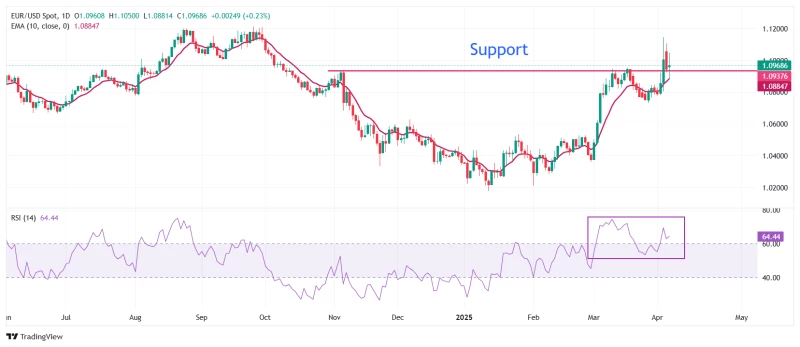The EUR/USD pair retreated during Monday trading, falling to near 1.0880 before recovering to around 1.0940, but still remaining down approximately 0.25% as the US Dollar strengthens following reports of a potential 90-day pause on new tariffs for most US trading partners.
EUR/USD Falls as Trump Administration Considers Tariff Implementation Delay
The EUR/USD currency pair experienced downward pressure on Monday as the US Dollar (USD) gained strength after recovering from earlier losses. The US Dollar Index (DXY), which measures the Greenback against six major currencies, climbed to near 103.20, boosting the dollar's position against the Euro.
According to Reuters, US National Economic Council Director Kevin Hassett has indicated that President Donald Trump is considering a 90-day pause on tariffs for all US trading partners except China. While the White House has not yet confirmed this report, such a delay would provide targeted nations significant time to negotiate deals with Washington to potentially avoid higher import duties altogether.
This development would likely benefit the US economy, which has faced downward revisions from market experts following President Trump's announcement of sweeping reciprocal tariffs the previous Wednesday. The proposed pause suggests the administration may be responsive to concerns about the economic impact of immediate tariff implementation.
EUR/USD Reacts to Trump's Market Comments and Fed Pressure
The tariffs announced by Trump initially created significant market turbulence, causing equity markets worldwide to decline sharply. However, Trump appeared unconcerned about investors' losses, suggesting that higher levies would generate substantial revenue for the United States annually. "I don't want anything to go down. But sometimes you have to take medicine to fix something," Trump stated while speaking on Air Force One over the weekend.
Economic experts had expressed growing concern about the US economic outlook, arguing that the real burden of increased import duties would fall on domestic importers. Investment bank JP Morgan had forecast that the US economy could experience a 0.3% decline in GDP growth by year's end if the tariffs were fully implemented as announced.
During European trading hours, Trump urged the Federal Reserve to begin cutting interest rates, claiming conditions have become favorable. Through a post on Truth Social, he wrote: "Oil prices are down, interest rates are down (the slow moving Fed should cut rates!), food prices are down, there is no inflation, and the long time abused USA is bringing in billions of dollars a week from the abusing countries on tariffs that are already in place."
Federal Reserve Chair Jerome Powell had stated on Friday that the President's protectionist policies could potentially increase inflationary pressures and slow economic growth. Nevertheless, Powell continues to support maintaining interest rates in the current range of 4.25%-4.50%, noting it is "too soon to say what will be the appropriate path for monetary policy."
EUR/USD Under Pressure as ECB Signals More Rate Cuts
The EUR/USD pair's decline is also influenced by uncertainty regarding the Euro's outlook. The European currency faces mounting pressure as European Central Bank (ECB) officials have downplayed concerns that tariff-driven inflation will persist in the Eurozone, allowing traders to increase bets on additional interest rate cuts this year.
ECB executive board member Isabel Schnabel, speaking at an economic forum in northern Italy over the weekend, warned that fresh US tariffs have exacerbated the Eurozone's structural economic challenges. Schnabel cautioned that higher import duties imposed by the US have generated a "dramatic surge in uncertainty," and the Eurozone should prepare for further challenges ahead.
The ECB has already lowered its key borrowing rates in both policy meetings held this year and is widely expected to implement another cut on April 17. The central bank will likely continue its gradual monetary policy easing, which would reduce the Deposit Facility rate to 2.25%. This scenario would generally be unfavorable for the Euro, contributing to the currency pair's current weakness.
During European trading hours, Eurostat reported that Retail Sales grew at a slower-than-expected pace on a monthly basis in February. The key measure of consumer spending rose by 0.3%, below estimates of 0.5%, after remaining flat in January. On an annual basis, consumer spending increased by 2.3%, stronger than both expectations and the prior release of 2.3%.
EUR/USD Finds Support Near 10-Day EMA as EU Seeks Tariff Negotiations
On the global front, European Commission President Von der Leyen commented during North American trading hours that the EU is ready to "negotiate with the US on tariffs," and intends to strengthen itself in response to Trump's tariff threats. Separately, European Union trade commissioner Maros Sefcovic stated, "We have offered to the US zero-for-zero tariffs for cars and all industrial goods." These positive diplomatic efforts by the Eurozone to mitigate fears of a potential trade war with the US could help ease domestic growth concerns.
From a technical analysis perspective, EUR/USD has resumed its upward journey after a healthy correction from the six-month high of 1.1145 reached on Thursday to near 1.0880 earlier in the day. The currency pair has rebounded as the 10-day Exponential Moving Average (EMA) provides significant support around 1.0886. The pair appears to be attempting to hold the key support level of 1.0938, which was established from the November 5 high.
The 14-day Relative Strength Index (RSI) remains above 60.00, suggesting that the bullish momentum remains intact despite the recent pullback. Looking at potential support levels, the March 31 high of 1.0850 will likely act as a major support zone for the pair. Conversely, the September 25 high of 1.1214 represents a key resistance barrier that Euro bulls would need to overcome to resume the broader uptrend.

 Saad Ullah
Saad Ullah

 Saad Ullah
Saad Ullah


